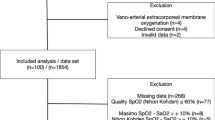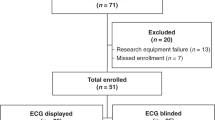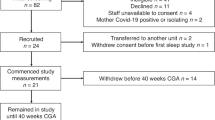Abstract
Objective
To compare the efficacy and reliability of two pulse-oximeters (POx) (Masimo Radical-7 and Nellcor™ Oxymax Bedside) and evaluate the feasibility of routine ECG monitoring during delivery room transition.
Study design
Prospective observational comparative study. Sixty newborns were connected simultaneously to both POxs and ECG monitor (as a gold standard for HR). Times to achieve a stable signal were compared. Heart rates were compared to simultaneous ECG.
Results
A significant difference in times to stable signal was found: Mean, Median (Interquartile range) for Nellcor and Masimo, were 15, 8.5 (6–18) and 27, 12 (9–34) seconds, respectively. Compared to ECG, false bradycardia was displayed in 18 of 55 (35%) newborns by the Masimo POx and in no newborns by the Nellcor POx. Attaching the ECG monitor was feasible but consumed additional resources.
Conclusions
The time for achievement of a stable saturation reading in an uncomplicated resuscitation setting differed significantly between POxs.
This is a preview of subscription content, access via your institution
Access options
Subscribe to this journal
Receive 12 print issues and online access
$259.00 per year
only $21.58 per issue
Buy this article
- Purchase on Springer Link
- Instant access to full article PDF
Prices may be subject to local taxes which are calculated during checkout



Similar content being viewed by others
References
Kattwinkel J, Perlman JM, Aziz K, Colby C, Fairchild K, Gallagher J, et al. Part 15: neonatal resuscitation: 2010 American Heart Association Guidelines for Cardiopulmonary Resuscitation and Emergency Cardiovascular Care. Circulation. 2010;122:S909–19.
O’Donnell CP1, Kamlin CO, Davis PG, Carlin JB, Morley CJ. Clinical assessment of infant colour at delivery. Arch Dis Child Fetal Neonatal Ed. 2007;92:F465–7.
Saugstad OD, Ramji S, Vento M. Oxygen for newborn resuscitation: how much is enough? Pediatrics. 2006;118:789–92.
Saugstad OD. Oxygen saturations immediately after birth. J Pediatr. 2006;148:569–70.
Saugstad OD. Oxidative stress in the newborn–a 30-yearperspective. Biol Neonate. 2005;88:228–36.
Ezaki S, Suzuki K, Kurishima C, Miura M, Weilin W, Hoshi R, et al. Resuscitation of preterm infants with reduced oxygen results in less oxidative stress than resuscitation with 100% oxygen. J Clin Biochem Nutr. 2009;44:111–8.
O’Donnell CPF, Kamlin COF, Davis PG, Morley CJ. Feasibility of and delay in obtaining pulse oximetry during neonatal resuscitation. J Pediatr. 2005;147:698–9.
Dawson JA, Davis PG, O’Donnell CP, Kamlin CO, Morley CJ. Pulse oximetry for monitoring infants in the delivery room: a review. Arch Dis Child Fetal Neonatal Ed. 2007;92:F4–7.
Wyckoff MH, Aziz K, Escobedo MB, Kapadia VS, Kattwinkel J, Perlman JM, et al. Part 13: neonatal resuscitation: 2015 American Heart Association Guidelines Update for Cardiopulmonary Resuscitation and Emergency Cardiovascular Care. Circulation. 2015;132:S543–60.
Hay WW, Rodden DJ. Reliability of conventional and new oximetry in neonatal patients. J Perinatol. 2002;22:360–6.
Sola A, Chow L, Rogido M. Pulse oximetry in neonatal care in 2005. A comprehensive state of the art review. Pediatr (Barc). 2005;62:266–81.
Bohnhorst B, Peter CS, Poets CF. Detection of hyperoxaemia in neonates: data from three new pulse oximeters. Arch Dis Child - Fetal Neonatal Ed. 2002;87:F217–9.
Bohnhorst B, Peter CS, Poets CF. Pulse oximeters’ reliability in detecting hypoxemia and bradycardia: Comparison between a conventional and two new generation oximeters. Crit Care Med. 2000;28:1565–68.
Dawson JA, Saraswat A, Simionato L, Thio M, Kamlin CO, Owen LS, et al. Comparison of heart rate and oxygen saturation measurements from Masimo and Nellcor pulse oximeters in newly born term infants. Acta Paediatrica. 2013;102:955–60.
Kamlin CO, Dawson JA, O’Donnell CP, Morley CJ, Donath SM, Sekhon J, et al. Accuracy of pulse oximetry measurement of heart rate of newborn infants in the delivery room. J Pediatr. 2008;152:747–8.
Heller GZ, Manuguerra M, Chow RL. How to analyze the Visual Analogue Scale: myths, truths and clinical relevance. Scand J Pain. 2016;13:67–74.
Dawson JA, Kamlin CO, Vento M, Wong C, Cole TJ, Donath SM, et al. Defining the Reference Range for Oxygen Saturation for Infants After Birth. Pediatrics. 2010;125:e1340–7.
Baquero H, Alviz R, Castillo A, Neira F, Sola A. Avoiding hyperoxemia during neonatal resuscitation: time to response of different SpO2 monitors. Acta Pædiatrica. 2011;100:515–18.
Van Vorderen JJ, Hooper SB, Kroese JK, Roest AA, Narayen IC, van Zwet EW, et al. Pulse oximetry measures a lower heart rate at birth compared with electrocardiography. J Pediatr. 2015;166:49–53.
Mizumoto H, Tomotaki S, Shibata H, Ueda K, Akashi R, Uchio H, et al. Electrocardiogram shows reliable heart rates much earlier than pulse oximetry during neonatal resuscitation. Pediatrics Int. 2012;54:205–7.
Katheria A, Rich W. Finer Nl. Electrocardiogram Provides a Continuous Heart Rate Faster Than Oximetry During Neonatal Resuscitation. Pediatrics. 2012;130:e1177–81.
Saugstad OD, Robertson NJ, Vento M. A critical review of the 2015 International Liaison Committee on Resuscitation treatment recommendations for resuscitating the newly born infant. Acta Paediatr. 2016;105:442–4.
Kamlin CO, O’Donnell CP, Everest NJ, Davis PG, Morley CJ. Accuracy of clinical assessment of infant heart rate in the delivery room. Resuscitation. 2006;71:319–21.
Funding
Masimo provided a pulse-oximeter and sensors for the study; they requested to see the data before publication. Nellcor provided sensors. Both companies had no role in the design, execution, interpretation, or writing of the study. No other funding needed beyond the mentioned.
Author information
Authors and Affiliations
Corresponding author
Ethics declarations
Conflict of interest
The authors declare that they have no conflict of interest.
Additional information
Publisher’s note Springer Nature remains neutral with regard to jurisdictional claims in published maps and institutional affiliations.
Rights and permissions
About this article
Cite this article
Khoury, R., Klinger, G., Shir, Y. et al. Monitoring oxygen saturation and heart rate during neonatal transition. comparison between two different pulse oximeters and electrocardiography. J Perinatol 41, 885–890 (2021). https://doi.org/10.1038/s41372-020-00881-y
Received:
Revised:
Accepted:
Published:
Issue Date:
DOI: https://doi.org/10.1038/s41372-020-00881-y



